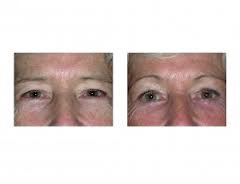Elevation of low or aging brows can be done by a variety of browlift procedures. But since its introduction in the mid-1990s, the endoscopic browlift has remained a popular method. Its appeal is in the much smaller incisions and the lack of scalp morbidity, such as scar widening and alopecia and persistent numbness that occurs from a transverse scalp incision regardless of whether it is at or way back in the hairline.
The advantages of the endoscopic browlift has never been an issue of debate, the reduction or elimination of complications. What is not as clear is whether it offers similar aesthetic benefits as more open traditional browlift operations…is it effective and does it have lasting effects? Given how long the endoscopic browlift has been around, one would assume that the clarity of its aesthetic effectiveness is well established and documented. While plastic surgeons, including myself, find it to be very effective in the properly selected patient its longer-term stability is less clear.
In the May 2013 issue of the journal Facial Plastic and Reconstructive Surgery, a published study shows that the majority of patients who had endoscopic browlift procedures were satisfied with its long-lasting results. The study reviewed 143 patients over a 13 year period based on questionnaires of satisfaction and postoperative complaints as well as before and after pictures of eyebrow-to-eye measurements.
The study showed that the vast majority of patients were women (96%) who had an average age of 60 years and was rated successful by 93% of patients with 96% saying they would recommend the bprocedure. Three-fourths( 64%) said they looked younger and less tired. Some scalp numbness and itching persisted 3 to 6 months after surgery. Photographic analysis found that brow elevation was maintined to at least 2 years after surgery with an average elevation of over 5mms.

Dr. Barry Eppley
Indianapolis, Indiana


